LG G2 and MSM8974 Snapdragon 800 - Mini Review
by Brian Klug on September 7, 2013 1:11 AM EST- Posted in
- Smartphones
- LG
- Mobile
- LG G2
- Android 4.2
- MSM8974
- Snapdragon 800
GPU Performance
Snapdragon 800 features Qualcomm's Adreno 330 GPU. Qualcomm hasn't stated publicly how Adreno 330 compares to Adreno 320 featured in Snapdragon 600, but it's almost certainly a larger GPU. The 8974 implementation in LG's G2 clocks the Adreno 330 GPU at a maximum of 450MHz, yet we see better performance than the 450MHz Adreno 320 in Snapdragon 600 - lending credibility to the idea of having more execution resources. There's also an 8974AB variant which includes a 100 MHz bump in GPU clocks up to 550 MHz.
3DMark
3DMark for Android features the Ice Storm benchmark and uses OpenGL ES 2.0. Ice Storm is divided into two graphics tests and a physics test. The first graphics test is geometry heavy while the second test is more pixel shader intensive. The physics test, as you might guess, is CPU bound and multithreaded. The overall score takes into account both graphics and physics tests. The benchmark is rendered to an offscreen buffer at 720p/1080p and then scaled up to the native resolution of the device being tested. This is a very similar approach we've seen by game developers to avoid rendering at native resolution on some of the ultra high resolution tablets. The beauty of 3DMark's approach here is the fact that all results are comparable, regardless of a device's native resolution. The downside is we don't get a good idea of how some of the ultra high resolution tablets would behave with these workloads running at their native (> 1080p) resolutions.
For these benchmarks we stuck with the default presets (720p, normal quality).
3DMark performance generally fell very close to Qualcomm's MSM8974 MDP/T, with one exception. The CPU bound physics tests had the G2 far lower down the list than I would've expected. Given that test is mostly a multithreaded CPU benchmark, it's entirely possible that the G2's thermal/frequency governors are set more conservatively there. The performance gains elsewhere over Snapdragon 600/Adreno 320 are huge, but 3DMark can be very influenced by CPU performance so it's not clear how much of this advantage is due to Adreno 330 or Krait 400.
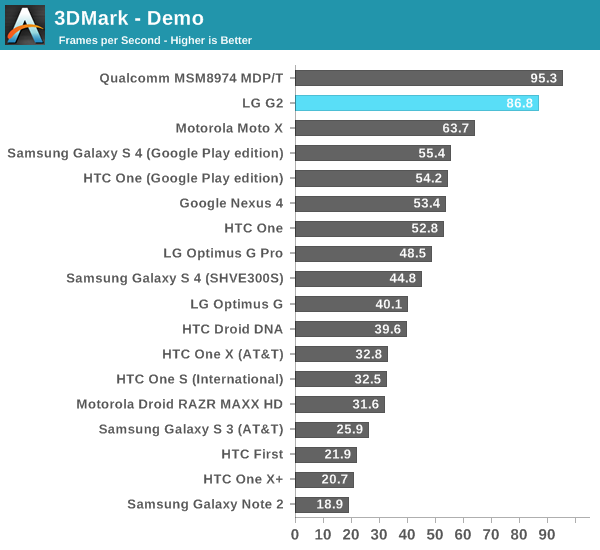
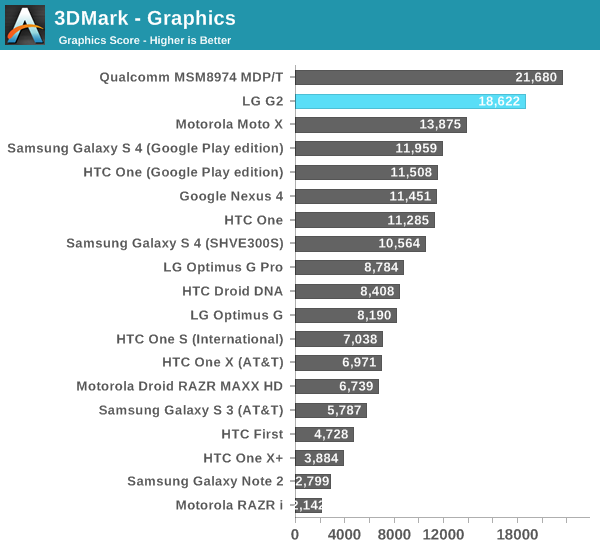
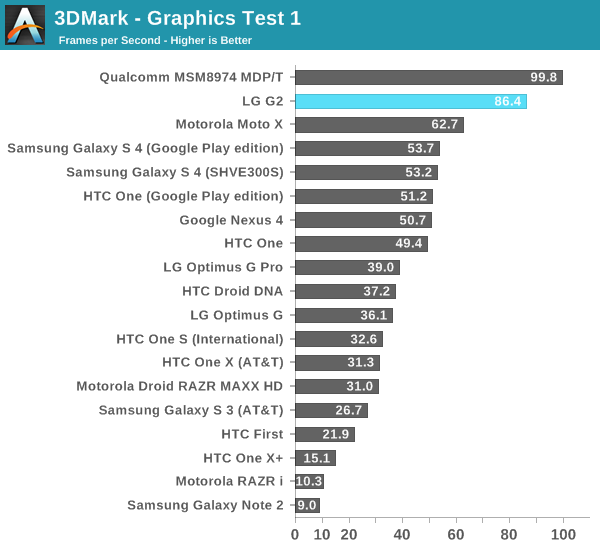
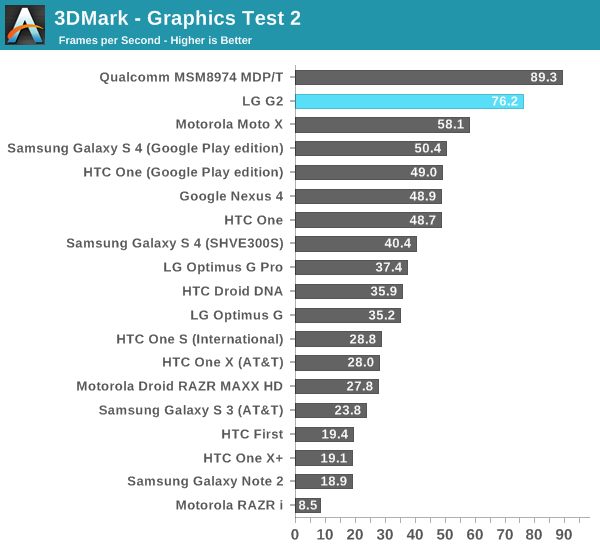
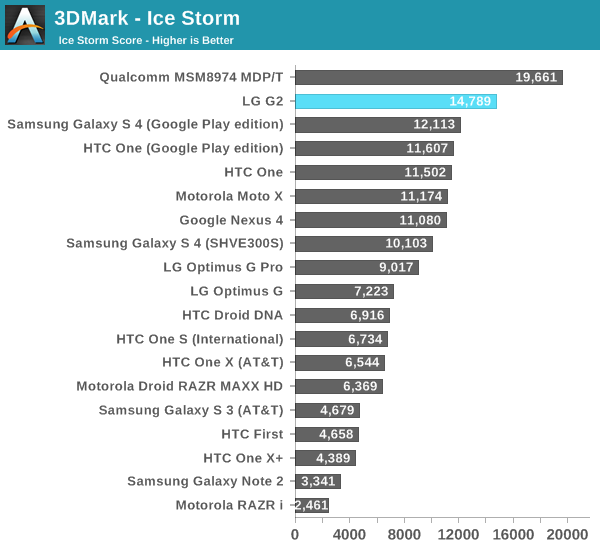
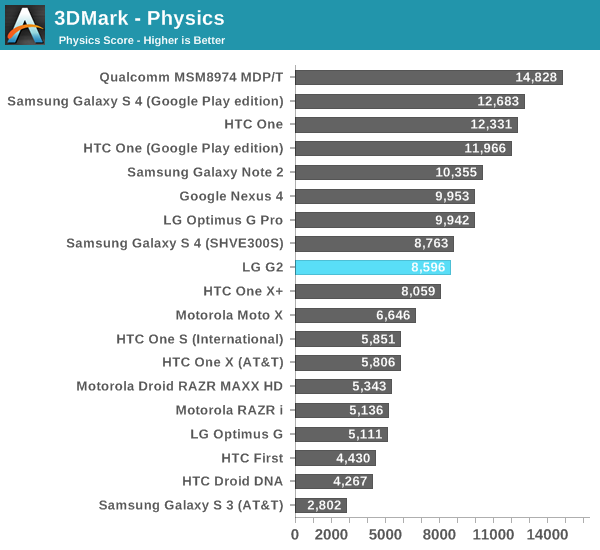
GFXBench 2.7
GFXBench (formerly GLBenchmark) gives us some low level insight into these platforms. As usual, we'll start with the low level tests and move onto the game simulation benchmarks:
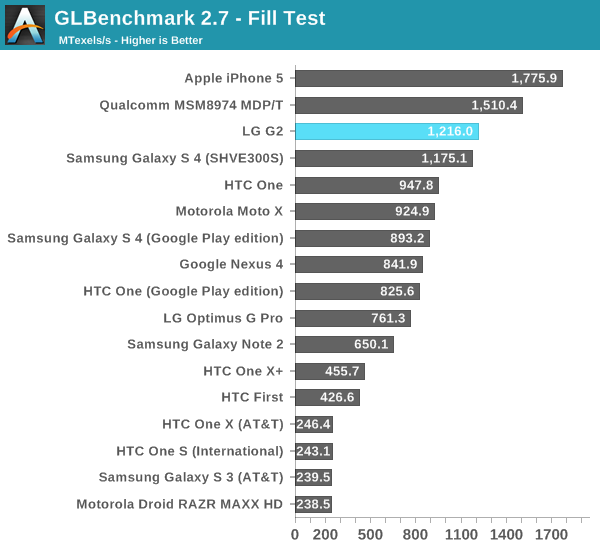
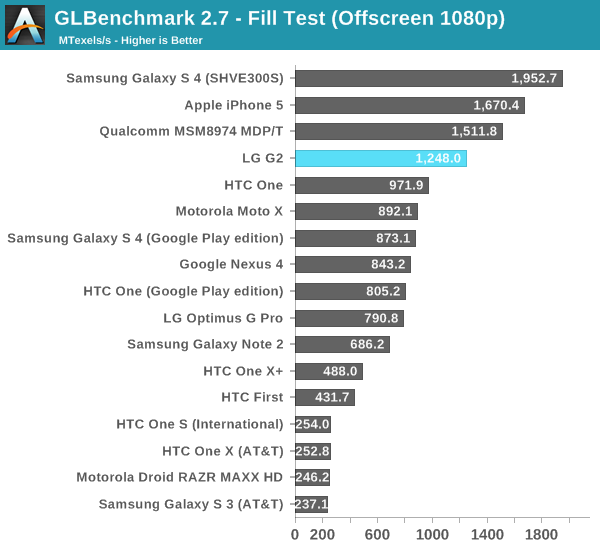
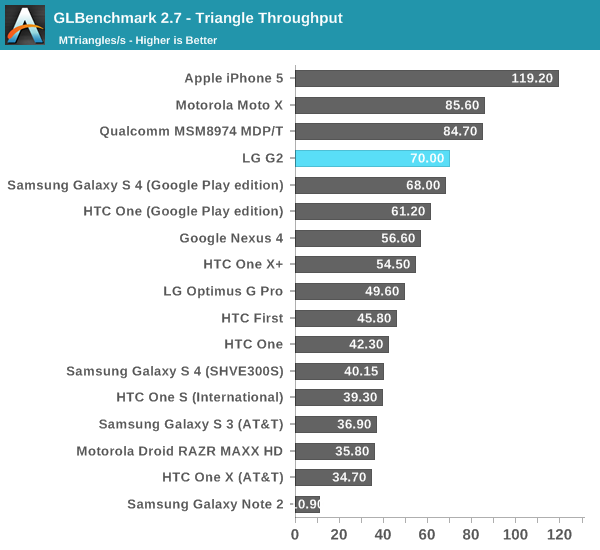
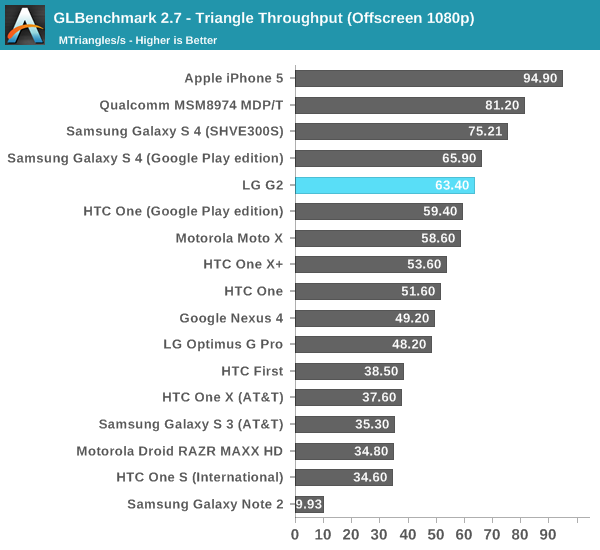
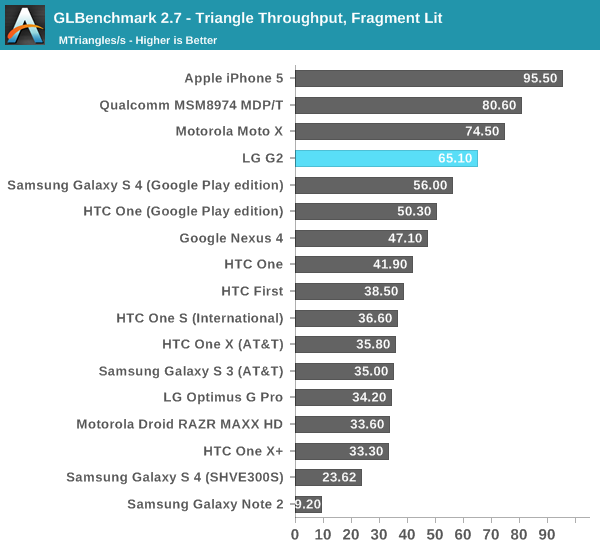
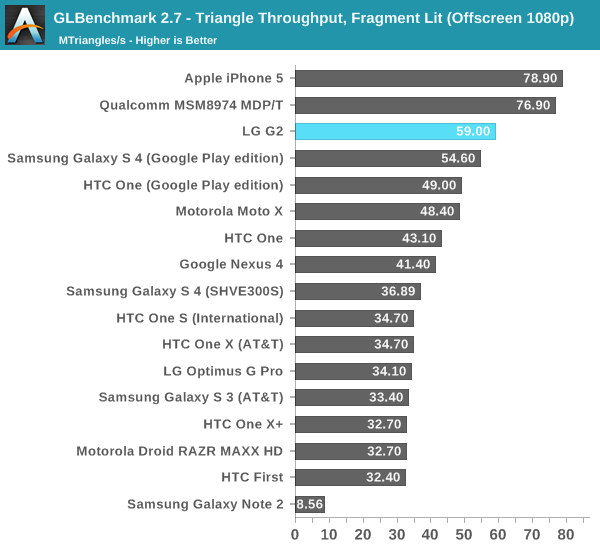
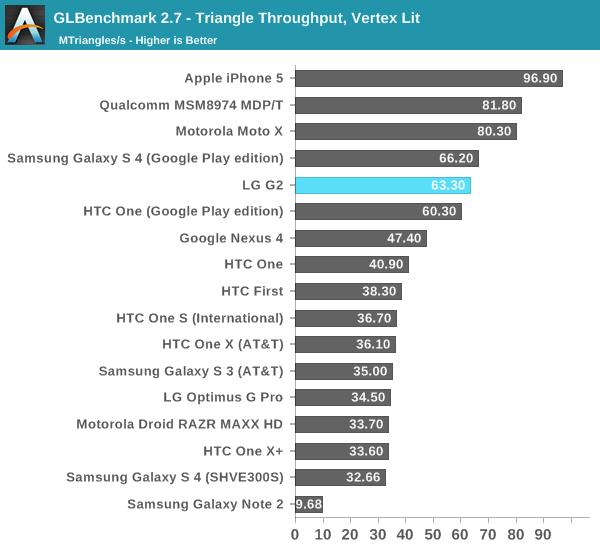
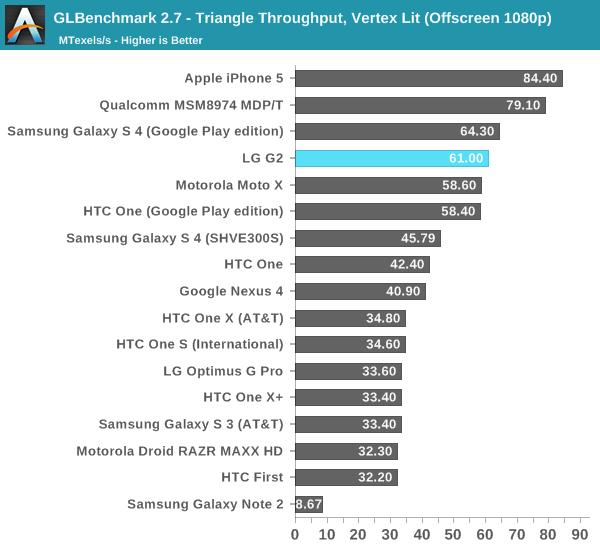
The low level tests put the G2 closer in performance to some of the Snapdragon 600 based devices than the MDP/T, again early software at work here. The T-Rex HD performance looks pretty good, putting the G2 between the S600 devices and S800 MDP/T.
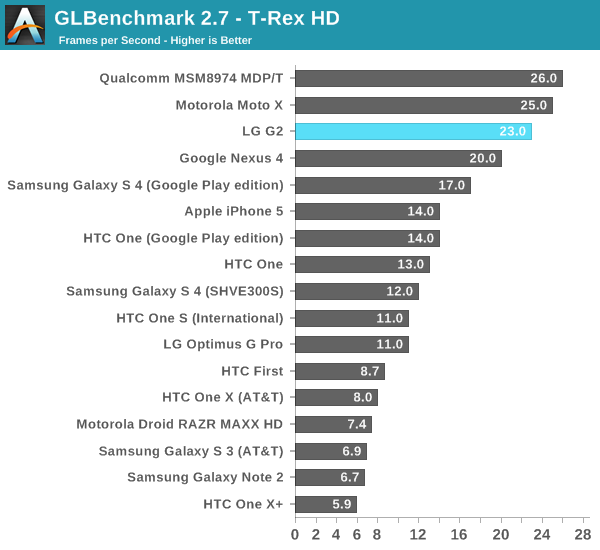
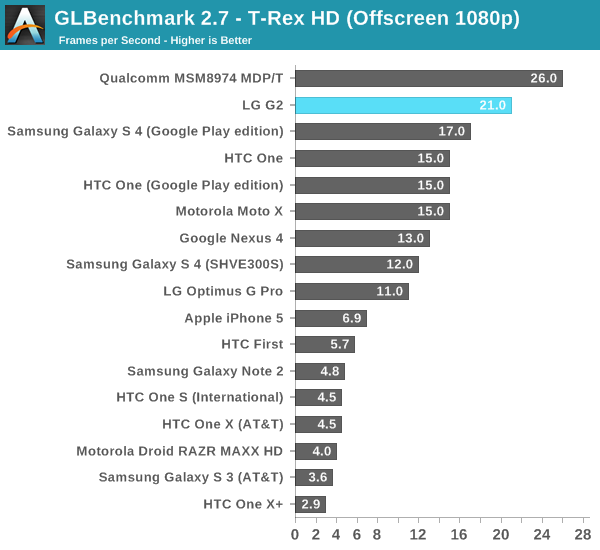
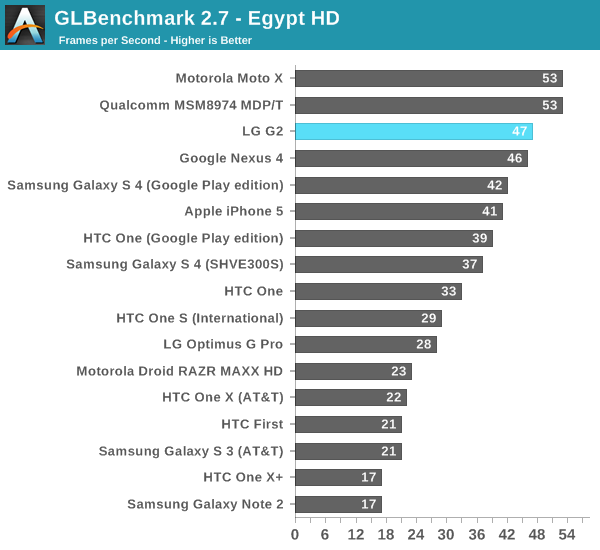
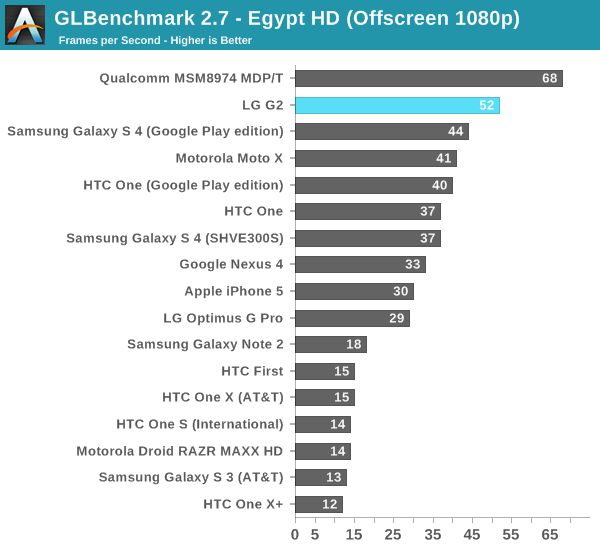
Basemark X
Basemark X is a new addition to our mobile GPU benchmark suite. There are no low level tests here, just some game simulation tests run at both onscreen (device resolution) and offscreen (1080p, no vsync) settings. The scene complexity is far closer to GLBenchmark 2.7 than the new 3DMark Ice Storm benchmark, so frame rates are pretty low:

Basemark X performance tracks with what we saw in the GFXBench T-Rex HD test. Performance is clearly higher than on any other device, but not quite up to MDP/T levels. I wonder how much closer the final device will get.
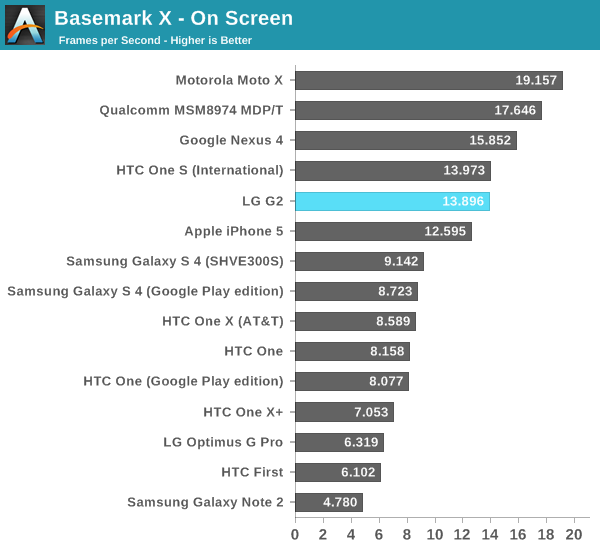
Epic Citadel
Epic's Citadel benchmark gives us a good indication of lighter workload, v-sync limited performance at native resolution. At 1080p, the Snapdragon 800 MDP/T offers over 50% better performance than the Snapdragon 600 based platforms. Granted we're comparing to smartphones here so there's some thermal advantage playing to the 800's favor.
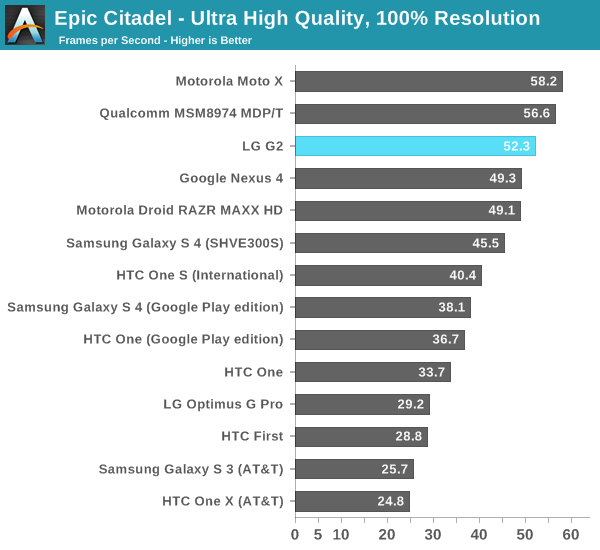










120 Comments
View All Comments
Impulses - Saturday, September 7, 2013 - link
I've got an EVO LTE but I'm on a similar boat, furthermore, this is the first tine in three years where I'm just not in a hurry to upgrade. Going to dual cores and 1GB of RAM was huge (EVO to EVO 3D), going from qHD to 720p and a much thinner device last year was also huge (not to mention ICS/JB)... Right now there's no hugely compelling hardware/software reason urging me to upgrade tho. I still might if this comes out as a Nexus 5 for $350 tho...RollingCamel - Saturday, September 7, 2013 - link
What about the audio codecs LG claimed support for? Did you try FLAC on it?maglito - Monday, September 9, 2013 - link
FLAC has native support on every 4.X android device.shackanaw - Monday, September 9, 2013 - link
He's referring to the 24-bit/192khz support and other improvements mentioned in the G2 hands on: http://www.anandtech.com/show/7205/hands-on-with-t..."LG has made audio in the line-out sense a priority for the G2. We’ve seen a lot of emphasis from other OEMs on speaker quality and stereo sound, with the G2 LG has put time into rewriting part of the ALSA stack and Android framework to support higher sampling and bit depth. The inability of the Android platform to support different sampling rates for different applications remains a big limitation for OEMs, one LG wrote around, and with the G2 up to 24 bit 192 kHz FLAC/WAV playback is supported in the stock player, and LG says it will make an API available for other apps to take advantage of this higher definition audio support to foster a better 24-bit ecosystem on Android.
"I asked about what codec the G2 uses, and it turns out this is the latest Qualcomm WCD part, which I believe is WCD9320 for the MSM8974 platform. LG says that although the previous WCD9310 device had limitations, the WCD9320 platform offers considerably better audio performance and quality that enables them to expose these higher quality modes and get good output. The entire audio chain (software, hardware codec, and headphone amplifier) have been optimized for good quality and support for these higher bit depths, I’m told. I didn’t get a chance to listen to line out audio, but hopefully in testing this emphasis will play itself out."
tuxRoller - Tuesday, September 10, 2013 - link
24bit playback is a gimmick since even the studio equipment, apparently, doesn't handle the full 24bit. Aside from that, you just don't need that much sample accuracy unless you're superman.http://xiph.org/~xiphmont/demo/neil-young.html
ssj3gohan - Saturday, September 7, 2013 - link
Why are the iPhone raw triangle/fill rate tests so much better than any other phone, yet does it perform middle of the pack in gfxbench and such? I was under the impression that they basically had the best graphics solution around, paired with awesomely optimized software.et20 - Saturday, September 7, 2013 - link
Apparently they didn't optimize for gfxbench.UpSpin - Saturday, September 7, 2013 - link
The meaningless synthetic benchmarks always favored iOS. The reason many people think that iPhones are magnitudes more powerful than Android devices.The only meaningful benchmarks are normal 3D scenes.
I don't understand why Anandtech still posts those meaningless benchmarks. Or can you read something out of them? NO! They are in no way a measurement for performance. They are basically useless. That's the reason we don't see them on desktop GPU comparisons.
tuxRoller - Saturday, September 7, 2013 - link
They give you a good idea of the device's capabilities in specific areas. Useful for doing a deep dive to determine what the make-up of the device is.For realworld use, you are absolutely right, and, imho, such synthetics only belong in articles where there are new components (like this one), but for the next snapdragon-800, I don't think those particular benchmarks need be run..
Krysto - Sunday, September 8, 2013 - link
Sunspider also seems pretty pointless at this point. Kraken and Octane seem to give more accurate results in terms of chip performance.